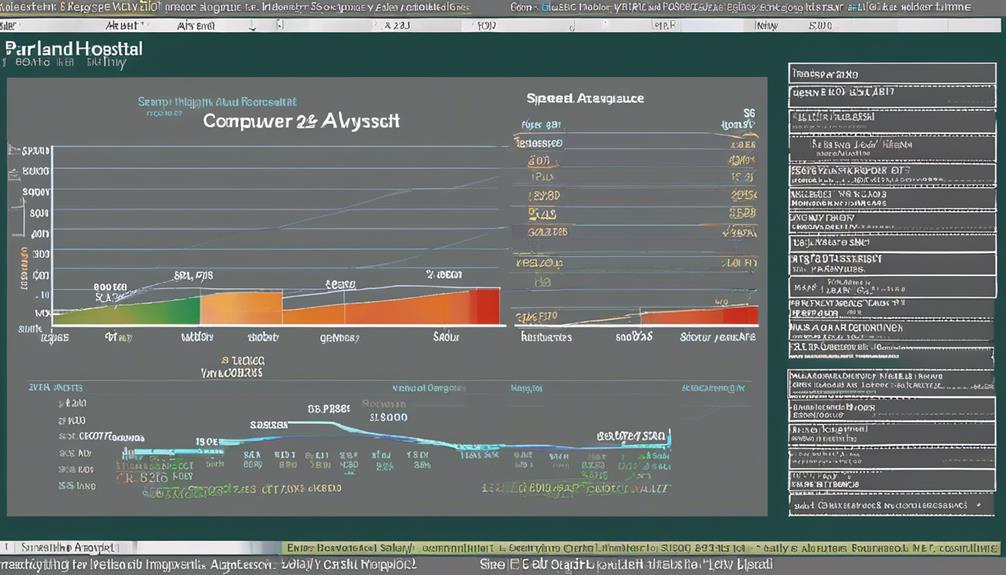Exploring the intricacies of maintaining software quality often leads to discussions about compensation. The salary range for a Software Quality Assurance Analyst at Parkland Hospital has caught the eye of numerous industry experts.
Understanding the factors that influence this remuneration is essential for individuals considering a career in quality assurance within a hospital setting.
Join us as we delve into the intricacies of compensation for Software Quality Assurance Analysts at Parkland Hospital, shedding light on the various components that contribute to their pay scale and offering insights into the prevailing trends in this domain.
Key Takeaways
- The salary range for the Software Quality Assurance Analyst position at Parkland Hospital is $22.61 to $27.23 per hour.
- The estimated average pay for a Software Quality Assurance Analyst at Parkland Hospital is $24.32 per hour, which is approximately 10% above the national average.
- Factors such as experience, education, specialized certifications, and level of responsibility within the Hospital System management influence the pay scale for Quality Assurance Analysts.
- Parkland Hospital offers a comprehensive benefits package, including financial perks, flexible spending accounts, and insurance coverage, contributing to the overall compensation package for Software Quality Assurance Analysts.
Salary Range for Software Quality Assurance Analyst
The salary range for the Software Quality Assurance Analyst position at Parkland Health & Hospital System is $22.61 to $27.23 per hour, approximately 10% above the national average. This pay scale reflects the competitive compensation offered at Parkland Hospital, which is a significant factor for professionals seeking employment in the United States.
As a Software Quality Assurance Analyst, the estimated average pay stands at $24.32 per hour, placing it within the specified range. It’s important to note that these figures are based on public and private data and should be used for generalized comparison. For precise details about the pay at Parkland Health, individuals are encouraged to consult with the employer regarding specific job details and salary information.
This salary range not only offers a competitive wage but also includes additional benefits such as health insurance, further enhancing the overall compensation package. Parkland Hospital’s commitment to providing an attractive pay scale for its Software Quality Assurance Analyst positions underlines its dedication to attracting and retaining top talent in the industry.
Factors Influencing Compensation for Quality Assurance Analyst

After evaluating industry standards and surveying employee satisfaction, we’ve identified several key factors that influence the compensation for Quality Assurance Analysts at Parkland Hospital.
The pay scale for a software quality assurance analyst is influenced by various factors such as experience, education, and additional skills. Analysts with specialized certifications or advanced degrees tend to command higher salaries due to their enhanced qualifications.
Moreover, the complexity of the role and the level of responsibility within the Hospital System management can also impact the pay estimate for a Quality Assurance Analyst.
Additionally, benefits such as health insurance and other perks contribute to the overall compensation package. The demand for specific technical expertise or knowledge in niche areas of healthcare technology can also influence the salary offered to a Quality Assurance Analyst.
As Parkland Hospital focuses on maintaining high standards in patient care and data security, the role of a Quality Assurance Analyst is pivotal, leading to competitive salaries to attract and retain top talent in this field.
Understanding Remuneration in Hospital Software Quality Assurance

Our team has thoroughly analyzed the remuneration structure for hospital software quality assurance, uncovering key insights into the compensation package.
At Parkland Health & Hospital System in the United States, the average pay for a software quality assurance analyst stands at $24.32 per hour, which surpasses the national average by 10%. The salary range for this job varies between $22.61 and $27.23 per hour.
In addition to competitive pay, Parkland offers a comprehensive benefits package, including financial perks, flexible spending accounts, and insurance coverage. It’s important to note that salary figures and benefits may fluctuate based on the specific jurisdiction and should be verified with the employer.
The remuneration at Parkland Health & Hospital System reflects the organization’s commitment to attracting and retaining top-quality talent in software quality assurance roles. This compensation package demonstrates the value placed on quality management within the healthcare sector, making it an enticing opportunity for professionals seeking a rewarding career in hospital software quality assurance.
Exploring the Pay Scale for Software Quality Assurance Analyst

Upon analyzing the pay scale for software quality assurance analysts at Parkland Health & Hospital System, it becomes evident that the compensation package offers competitive rates and comprehensive benefits. The estimated average pay for this position is $24.32 per hour, with the pay scale ranging from $22.61 to $27.23 per hour. This places the salary approximately 10% above the national average for similar positions in the United States. In addition to the base salary, Parkland Health & Hospital System provides a range of benefits including financial perks, flexible spending accounts, and various insurance options such as vision, health, and dental insurance. It is important to note that the actual salary figures and specific benefits should be confirmed by consulting with the employer directly.
| Pay Scale for Software Quality Assurance Analyst | Amount |
|---|---|
| Average Pay | $24.32 |
| Pay Range | $22.61 – $27.23 |
| National Average | 10% above |
| Benefits | Financial perks, flexible spending accounts, various insurances |
This data showcases the competitive pay and comprehensive benefits offered to software quality assurance analysts at Parkland Health & Hospital System.
Insights Into Software Quality Assurance Analyst Compensation at Parland Hospital
We have gained valuable insights into the compensation for software quality assurance analysts at Parkland Health & Hospital System.
The estimated average pay for this role is $24.32 per hour, with a pay range from $22.61 (low) to $27.23 (high) per hour. Notably, this average pay is 10% above the national average for similar positions in the United States.
In addition to competitive pay, Parkland Health & Hospital System offers a comprehensive benefits package, including financial perks, flexible spending accounts, and insurance covering vision, health, and dental needs.
The company also boasts a positive rating for job work/life balance, compensation and benefits, job security and advancement, as well as management.
These insights provide a clear picture of the attractive compensation package and overall job satisfaction that software quality assurance analysts can expect at Parkland Health & Hospital System.
In addition to the competitive salary, the benefits and positive work environment make this an appealing opportunity for individuals in the software quality assurance field.
Frequently Asked Questions
What Is the Highest Salary for a Quality Assurance Analyst?
The highest salary for a quality assurance analyst is $32.99 per hour at Parkland Health & Hospital System.
This figure is 15% above the national average for this role.
Keep in mind that these numbers are based on available data and may not be officially endorsed by the employer.
It’s important to consider other factors such as benefits and career growth opportunities when evaluating compensation packages.
What Is the Highest Salary for a QA Analyst?
The highest salary for a QA analyst at Parkland Hospital is $32.99 per hour. This amount is 15% above the national average. We can visualize this as a competitive edge in the market.
Parkland’s estimated average pay for this role is $29.45 per hour, with the low end of the pay range at $27.39 per hour.
On average, a QA analyst at Parkland receives around $61,256 annually.
How Much Does a Quality Assurance Analyst Make in Dallas Texas?
In Dallas, Texas, a Quality Assurance Analyst typically makes an average of $24.32 per hour, which is 10% above the national average. The pay range for this role in Dallas is between $22.61 and $27.23 per hour.
It’s important to verify these figures and inquire about benefits directly from the employer.
Conclusion
Well, it looks like being a Software Quality Assurance Analyst at Parkland Hospital means you’ll be making some serious dough.
Who knew finding bugs and glitches could be so lucrative?
Maybe I should consider a career change…









